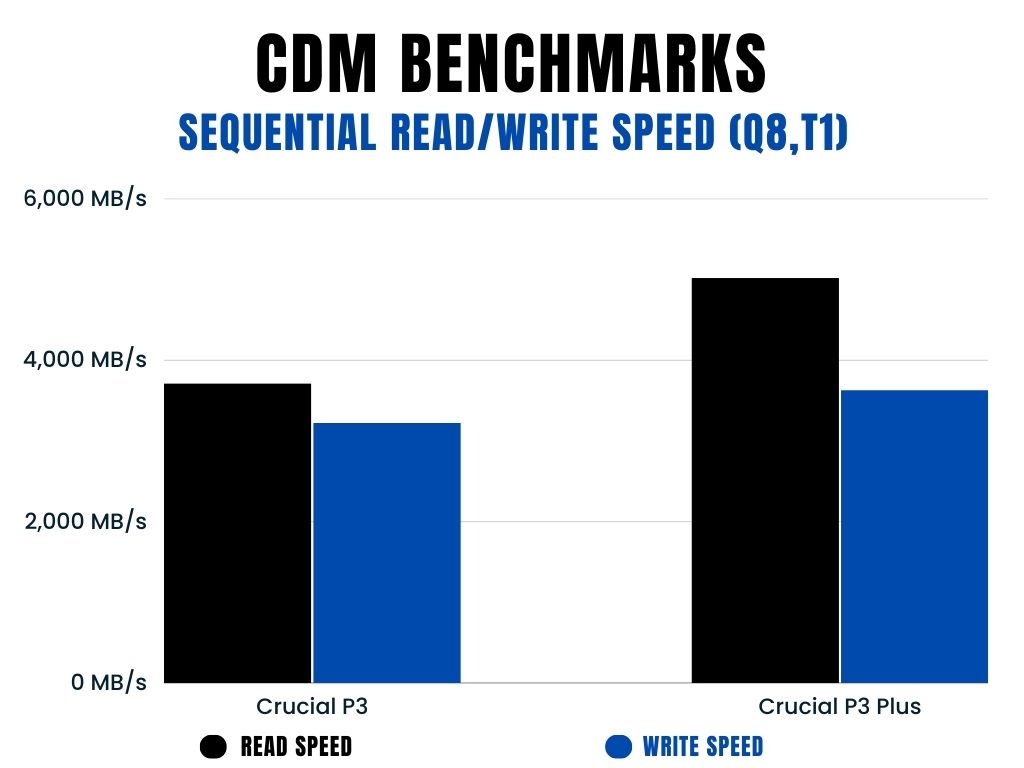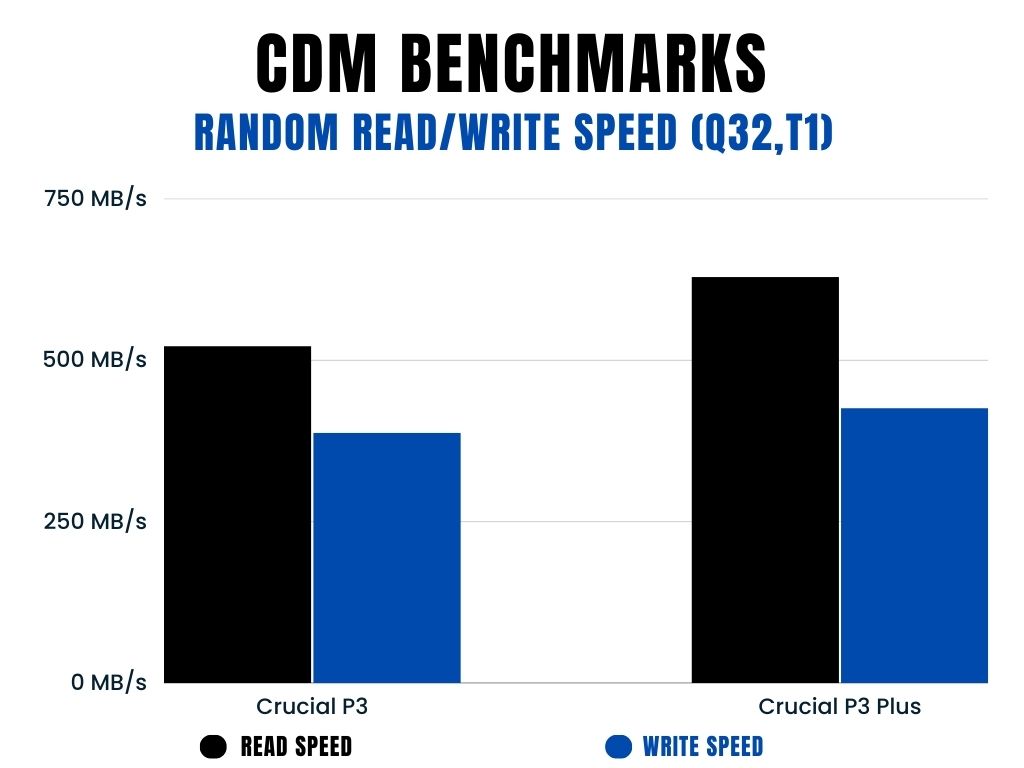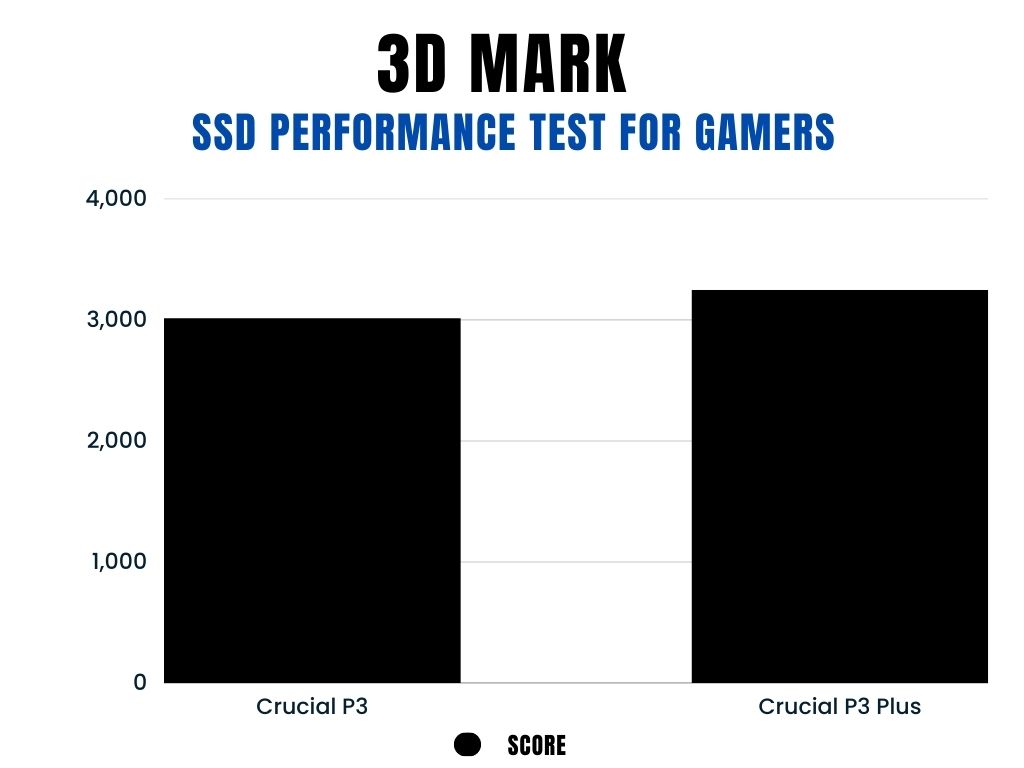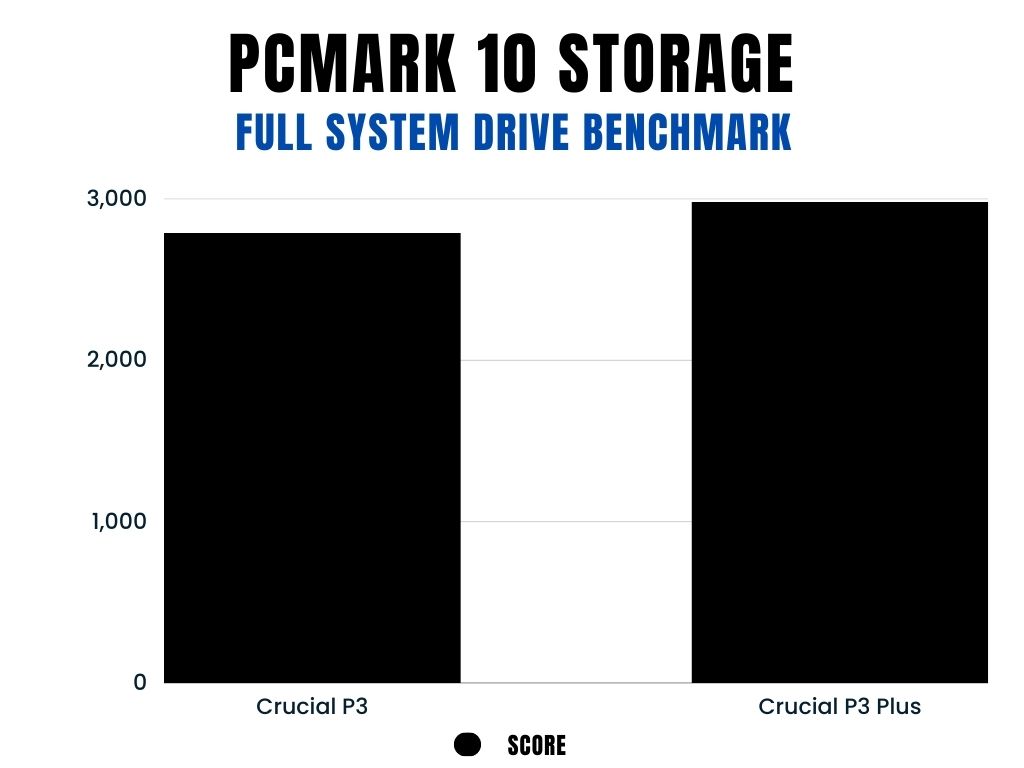If you are confused between Crucial P3 and Crucial P3 Plus SSDs, you are at the right place. Their names might sound similar but there are big differences in the technology and performance as well.
The Crucial P3 is a Gen 3 SSD while the P3 Plus can be called the upgraded Gen 4 version of the same. It is quite clear that the P3 Plus will be a much more capable SSD in terms of performance. But, the P3 will also be suitable for some kinds of users.
If we talk about the theoretical read/write speed metrics, P5 Plus is ahead in all areas.
We are going to discuss all which will help to make your final decision between both of these. So, let’s start.
Theoretical Performance Difference
| Specification | Crucial P3 | Crucial P3 Plus |
|---|---|---|
| Storage Variants | 500GB, 1TB, 2TB, 4TB | 500GB, 1TB, 2TB, 4TB |
| Interface | PCIe 3.0×4 | PCIe 4.0×4 |
| NAND Flash | 176-layer QLC NAND (Micron) | 176-layer QLC NAND (Micron) |
| Theoretical Read Speed (Seq) | Up to 3,500 MB/s | Up to 4,800 MB/s |
| Theoretical Write Speed (Seq) | Up to 3,000 MB/s | Up to 4,100 MB/s |
| Warranty | 5 Years | 5 Years |
| Availability | Check Amazon | Check Amazon |
It is clear that the P3 Plus is going to give you a better performance because of its advanced technology. But, there are various other things to see. Let’s see them below.
Benchmark Scores Comparison
Sequential Read/Write Speed (CDM)

Random Read/Write Speed (CDM)

3D Mark SSD Performance Test for Gamers

PCMark 10 Full Drive Benchmark

Results: In head-to-head benchmark testing, the Crucial P3 Plus SSD emerges as the clear frontrunner when compared to the standard Crucial P3 SSD. The Crucial P3 Plus showcases its exceptional performance prowess, boasting faster read and write speeds, significantly reducing data transfer times and enhancing overall system responsiveness. These benchmark results unequivocally favor the Crucial P3 Plus, solidifying its position as a top-tier choice for users seeking unmatched speed and efficiency in their storage solutions.
Endurance and TBW
| Capacity | Crucial P3 | Crucial P3 Plus |
|---|---|---|
| 500GB | 110TB | 110TB |
| 1TB | 220TB | 220TB |
| 2TB | 440TB | 440TB |
| 4TB | 800TB | 800TB |
The table presents a comprehensive comparison of the Total Bytes Written (TBW) ratings for both the Crucial P3 and Crucial P3 Plus SSDs across varying capacity options. TBW serves as a crucial metric in assessing an SSD’s endurance and longevity, indicating the amount of data that can be written to the drive over its lifespan.
Notably, the Crucial P3 and Crucial P3 Plus exhibit commendable TBW ratings, ensuring robust performance and data reliability for different usage scenarios. The table showcases that both SSDs offer similar TBW ratings for each capacity tier, with the Crucial P3 Plus maintaining parity with the Crucial P3.
Technical Specifications Comparison
| Technical Specification | Crucial P3 | Crucial P3 Plus |
|---|---|---|
| NAND Flash Type | 176-Layer Micron QLC (N48R) | 176-Layer Micron QLC (N48R) |
| Controller | Phison E21T | Phison E21T |
| Form Factor | M.2 2280 | M.2 2280 |
| Interface | PCIe 3.0 x4 | PCIe 4.0 x4 |
| Sequential Read | 3,500 MBps | 4,700 – 5,000 MBps |
| Sequential Write | 1,900 – 3,000 MBps | 1,900 – 4,200 MBps |
| DRAM | No (HMB) | No (HMB) |
| Flash Memory | 176-Layer Micron QLC (N48R) | 176-Layer Micron QLC (N48R) |
| SLC Cache | Approx. 250GB in 1TB | Approx. 250GB in 1TB |
| Heatsink Option | Not Available | Available |
| T.R.I.M. | Available | Available |
| S.M.A.R.T. | Available | Available |
| Encryption | Not Available | Available |
The controller of both models is the Phison E21T, offering a solid foundation for efficient data management. In terms of form factor, both the Crucial P3 and Crucial P3 Plus come in the widely supported M.2 2280 size, ensuring compatibility with a range of systems.
The interface speeds vary, with the Crucial P3 featuring PCIe 3.0 x4, while the Crucial P3 Plus showcases PCIe 4.0 x4. This distinction directly influences the impressive sequential read speeds of the Crucial P3 Plus, reaching an impressive range of 4,700 MBps to 5,000 MBps, outpacing the Crucial P3’s 3,500 MBps. Similarly, the Crucial P3 Plus delivers heightened sequential write speeds, ranging from 1,900 MBps to 4,200 MBps, compared to the Crucial P3’s 1,900 MBps to 3,000 MBps.
Although both models employ a Host Memory Buffer (HMB) instead of dedicated DRAM, this design choice doesn’t compromise their efficiency. Both SSDs feature 176-layer Micron QLC (N48R) flash memory, ensuring robust performance and reliability.
It’s worth noting that the Crucial P3 Plus offers a heatsink option, which can be beneficial for maintaining optimal operating temperatures, and enhancing sustained performance during demanding tasks. Additionally, both models support T.R.I.M. and S.M.A.R.T., providing valuable tools for managing and monitoring the health of the drives.
While encryption isn’t available on the Crucial P3, the Crucial P3 Plus offers encryption as an added layer of security for safeguarding sensitive data.
In summary, this comprehensive table offers a comprehensive view of the technical details that differentiate the Crucial P3 and Crucial P3 Plus SSDs. This information empowers users to make informed decisions based on their specific needs, ensuring that they choose an SSD that aligns with their requirements for speed, performance, and features.”
Price


Which one to buy? Crucial P3 or P3 Plus
For users seeking top-tier performance and cutting-edge technology, the Crucial P3 Plus emerges as a good choice. Its utilization of PCIe 4.0 x4 interface grants it a distinct advantage in sequential read and write speeds, making it ideal for power users, content creators, and gamers who demand lightning-fast data transfers and responsiveness. However, this is not the ideal performance you expect with any other top-tier 4th gen SSD. But, as per the price tag, it is still a good option.
On the other hand, the Crucial P3 doesn’t lag far behind. With its PCIe 3.0 x4 interface, it delivers substantial read and write speeds, catering to a wide array of everyday computing needs. Its affordability, combined with its respectable performance, makes it an excellent option for users seeking a reliable and cost-effective storage upgrade.
In essence, the choice between the Crucial P3 and Crucial P3 Plus hinges on your specific demands. If you require unrivaled speed and advanced features, the Crucial P3 Plus is the clear contender. Alternatively, the Crucial P3 provides a balanced solution, delivering commendable performance without stretching the budget.
Thanks for reading!